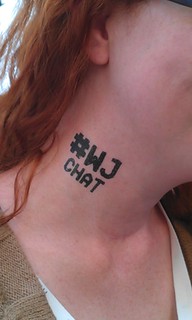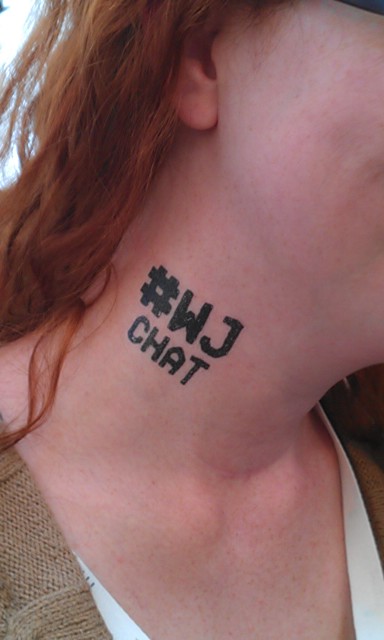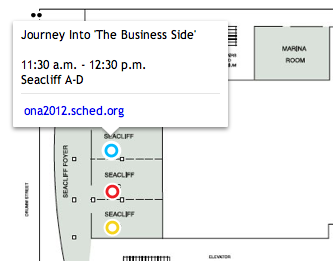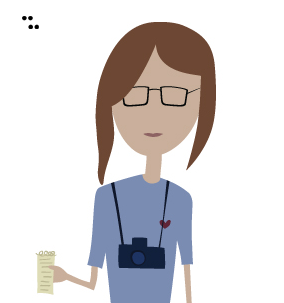The ONA conference is a chance for journalists from around the world to come together and discuss storytelling in the digital age. But journalists aren’t disconnected in the year between each conference. They are, after all, online journalists who use social media.
Two of the most popular online chats teamed up to throw an in-person meet-up at the conference. The Web journalists Twitter chat, or #wjchat, and the social journalism group on Facebook, or #socjourn, hosted a party Friday afternoon offering conference attendees a chance to relax, meet colleagues and connect with friends they talk to online every week.
Ian Hill, the online community engagement specialist at KQED in San Francisco, was late to #socjourn. When he joined, it was already well established, but he said that is what drew him to it.
“When I took the job as news engagement prod at KQED in 2010, one of my first jobs was to reach out to people in my position in public media and outside just to see what other people were doing and find collaboration opportunities,” he said. “Someone invited me into the group, and I’ve been with it since.”

Both groups started out as a way for journalists to connect with each other. Kim Bui, a co-founder of #wjchat, said the group began when some journalists grew frustrated with the public relations focus that many Twitter chats had. A few connections on Google Wave later, and the weekly chat was set up.
Craig Kanalley, a senior editor at The Huffington Post, founded #socjourn to give online journalists a place to discuss what new tools were available and what worked best for different situations.
The popularity of #wjchat and #socjourn spread through word of mouth, as journalists recommended the chats to each other as a way to learn new things.
“I just kind of found out about it,” said Sam Cohen, executive producer of digital content at Fox40 KTXL in Sacramento. “I started following people who were using the same hashtag, so I started following it.”
Part of the appeal for the groups comes from the fact that it’s journalists talking to journalists, letting everyone bounce ideas off one another.
“There are a lot of great, both private and pub, Facebook groups and chats on Twitter that are useful for journalists,” Hill said. “Facebook groups have become a great place for people to share information, and a lot of them are private, so people feel a lot more free to just kind of talk among others that are at the same level they are and have the same experiences they do.”
The attendees at the party said that not only are the groups a great place for journalists to connect, but they are also something journalism students should use to both grow as reporters and learn from their peers.
“I think if you’re a journalist and not taking advantage of that, you’re crazy. You’re setting yourself up for failure big time,” Hill said. “Technology has made it so easy to connect with other people who are doing some very exciting things online.”
A number of members in both #socjourn and #wjchat first got involved with the groups during college and found the connection with their peers helpful. Kaitlin Flanigan, who now works for NECN in Boston, said the professor who introduced her to Twitter told her to get onto #wjchat. Once there, Flanigan said, she was hooked.
“Not only do I feel like I gain more knowledge and more understanding of journalism, I feel like I have more mentors and friends as a result,” she said. “It’s nice to meet people in similar situations. You’re in college, about to graduate, trying to figure out what you’re doing with the rest of your life.”
The party turned out to be very popular, with more than 100 people on the waiting list. Members checked in on Foursquare, tweeted photos and picked up gifts such as #wjchat temporary tattoos.

Co-sponsored by Storify, the Tiziano Project and Annenberg School for Communication and Journalism at the University of Southern California, the event was a chance for the groups’ founders to see online connections come together in real life.
“I look at this room and people who are influenced by #wjchat, and I’m blown away,” said Bui, social media editor at KPCC, Los Angeles. “I wasn’t expecting this. These people are amazing. It’s great that we can do this and effect change, and just make one person happy.”
One element of ONA that attendees found exciting and odd is meeting online contacts face to face.
“It’s strange,” said Brian Manzullo, the sports Web editor of the Detroit Free Press. “Sometimes when I first look at people, I think ‘I know that person.’”
A few members said it was odd to introduce themselves to others.
“It’s a little intimidating because you know them, but you don’t actually know them,” said Erika Owens, community manager of the Knight-Mozilla OpenNews. “The most intimidating thing is introducing yourself and saying, ‘I know you from Twitter!'”
Others who have attended before said in-person meet-ups are much more exciting.
“It’s like meeting old friends. It’s funny because you’ll walk through the conference and you’ll recognize people from their Twitter pictures and Facebook avatars,” Hill said. “There’s a lot written about how Facebook is impacting interpersonal relationships and whether or not it’s detrimental to that. But when you come to events like this, it’s that reunion feeling you get: ‘I haven’t seen you in a long time. Let’s get coffee.’ You go back to your newsroom and you have a stronger bond built.”
Bui hopes the groups will continue to grow and that more people will get involved and contribute their own experiences. She wants to create “a community where we can learn and support and grow from each other.”
“The great thing about it is that everybody there is willing to talk to you know matter how big they are,” Hill said.






